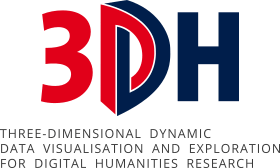Second Co-Creation-Workshop in Potsdam May 31st, 2017
We are halfway through our lecture period by now and since our first co-creation workshop in Potsdam at the end of April a lot has happened.
The concept sketches that were created by our five student groups during the first workshop were elaborated on in preparation for the next exchange between Hamburg and Potsdam.
On May 10th, Marian Dörk and I, together with the Potsdam interface design students, visited Chris Meister, Rabea Kleymann and the other members of the team to join Chris’ seminar and the accompanying exercise.
In the seminar Chris gave an introduction to the collaborative annotation tool Catma and explained to the Potsdam students, how you would use the tool with a certain literary question in mind. This introduction was meant to serve as a primer to Catma on the one hand, but also as an insight into the literary scholar’s process. Since the Potsdam students are supposed to base their visualizations on real data, i.e. narratological annotations produced in Catma, we deemed it necessary to make them comfortable with the process and the tools. The annotations they will eventually use, will be produced and made available to them by the Hamburg students via Catma.
In the exercise the interface design students presented their refined concepts in front of the Hamburg students and Chris Meister’s team. The concepts were quite diverse, in terms of narratological questions they were supposed to address, as well as media, technology and design. The images depicted below give an impression.
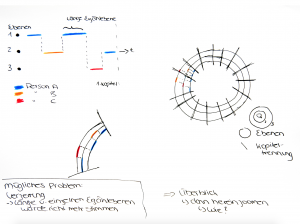
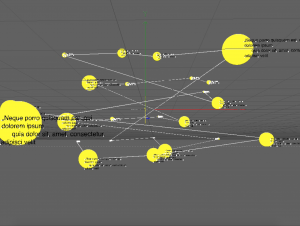
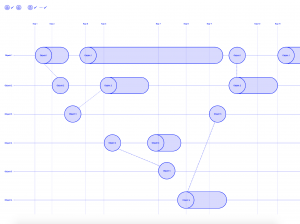
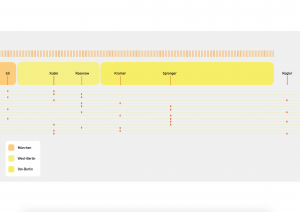
Sketches from short presentation in Hamburg
The predominant issues addressed with the concepts were, among others: narrative levels, advanced text search, narrative polarities and relations between objects, characters and parts of the text. After each presentation the literary scholars gave feedback on the projects. In the following three weeks the students had time to continue working on their concepts, before the two student groups from Hamburg and Potsdam got together again.
On May 31st our second co-creation workshop took place at the University of Applied Sciences Potsdam. The goal of this workshop was to sharpen the students’ concepts with respect to their ability to help answering narratological questions. In the first part of the workshop the student groups presented their current status followed each by a short discussion. In the second part all of the interface design student groups in Potsdam were assigned one or more students or researchers from Hamburg and worked on reifying their concepts. This session was also meant as a chance for the interface design students to ask questions regarding narratological analysis that they had collected over the past weeks.
In the weeks before there had been some rearrangements within the groups and some conceptual reorientations. At the moment there are six groups and their concepts are summarized in the following.
Storylines
Idea of this concept is to mark frame narratives and embedded narratives in the text and visualize their nesting on different levels of detail. These representations will be combined with contentual information, so viewers are informed about the interplay between structure and content.
Narrative Levels
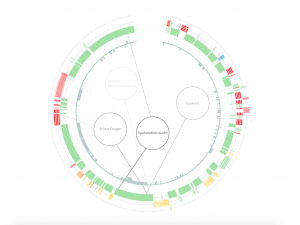
Narrative levels concept
In this circular visualization ring segments represent narrative levels of different order. In the center different relations between levels are visualized, like for example, character networks or the duration and frequency of certain events.
Manual Topic Modeling
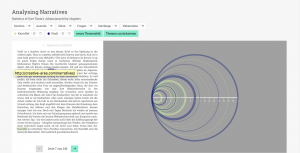
Manual topic modeling tool concept
The students developed a tool that let’s you search for the occurrence of words and let’s you manually define topics by putting words together. The distribution of these words can then be visualized. The group is currently looking into other text analysis features that might be helpful for narratological analysis.
Influences
The group wants to visualize influences on the protagonist of a novel. From a narratological perspective it could be interesting to analyze the development of the characterization of the protagonist over the course of the novel. The next step for the group will be to collect all text passages that characterize the protagonist and develop a suitable metric that can be visualized to represent the characterization. In a further step this could be related to the context surrounding a characterizing passage.
Nodes

Nodes concept
In this concept the attraction and repulsion between different entities (characters, objects, text fragments, for example) in the text is visualized in a VR environment (Google Cardboard). Attributes that influence the degree of attraction or repulsion are, for example, frequency or proximity in the text. Different entities can be pinned to get an impression, how they relate to other entities. This way it becomes possible to assume the perspective of a particular entity.
Narratological Cards
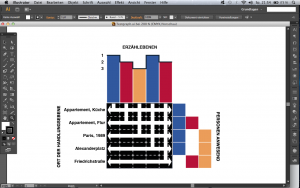
Narratological cards concept
In this concept a set of visual modules allows users to analyze a narrative in a physical way by putting together cards that represent different narratological features, like narrators or narrative levels, their position in the narrative and their interconnections.
Our hope is that this close collaboration between the two student groups over the whole course of the semester continues in such a fruitful way and will eventually lead to visualization tools that are truly user-centered and oriented towards the needs of narratologists.
Merken

